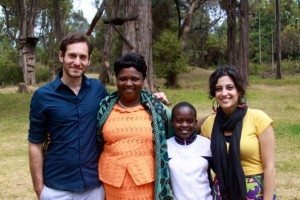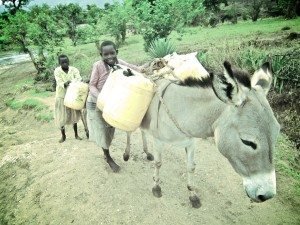Growing up in the United States has given me relatively free access to clean water. I can bathe in it, cook with it, and consume it whenever I choose to without worry. Most of us take this element for granted and can’t fathom a world without easy access to clean water. Yet, according to the World Health Organization (WHO), more than 3.4 million people die each year from water-, sanitation-, and hygiene-related causes. That is almost the size of Los Angeles! And 780 million people lack access to clean water, which is more than 2.5 times the United States population. An American taking a five-minute shower uses more water than the average person in the slums of a developing country uses during an entire day. These facts always fueled a desire in me to assist developing countries in obtaining clean water, and although I have not yet embarked on this engineering venture, I know of someone who has.

Lussia Kamberian Weber and her husband, Ryan Weber, both grew up in the United States, but decided to forgo comfort when they enlisted in the Peace Corps. In June 2011, they arrived in Kenya and went through an intense 10-week training program on water and sanitation, HIV, AIDS, malaria, and the Swahili language. They were also trained on community outreach and how to properly approach the villagers about these important health topics. Lussia and Ryan were officially sworn in on Aug. 17, 2011, and Lussia was asked to give a speech entirely in Swahili to the Kenyan press and media about their project goals.
Ryan and Lussia began their work right away in the town of Kapenguria for the Yang’at Community Development Organization. Yang’at means “care” in the local Pokot language. There are 52 tribes in Kenya, and they are working with the Pokot tribe. The Pokot tribes live in an arid to semi-arid part of north-western Kenya. They are a semi-nomadic tribe, with some villages taking permanent residences in a few areas. Lussia and Ryan conducted, and are still conducting, health trainings in water hygiene, Malaria, STI’s, AIDS/HIV, and FGM (female genital mutilation). The Pokot tribe still practices female circumcision, and Lussia has held private sessions with the women regarding the subject. To date, they’ve trained over a 1,500 people on health issues that affect their communities.
The biggest challenge Lussia and Ryan encounter is building and repairing shallow wells in West Pokot, Kenya. To date, they have repaired three of the seven broken wells, and their goal is to fix all seven. “It costs about $600 to repair each one. Yang’at also constructs sand dams,” Lussia told me during our interview. Sand dams are not like regular dams. A cement wall is built along a seasonal river, which then traps sand against the wall. The sand then acts as a sponge to hold the water in, and once the water stays trapped the river will start to flow again. This method allows the villagers to dig into the sand during dry season and collect the water that’s trapped underneath the surface. Once the sand dam is deemed a success, Lussia and Ryan move on to phase two, and build the dam higher to help increase the water table in order to build a shallow well. The project costs around $20,000, and is funded by a donor group called Church World Service (CWS).
When they first visit a town, Lussia explained, they introduce the well repair project to the community and open the pump to see what the problem is. They designate community members to a water committee, who then meet with Lussia and Ryan during their second visit for training on well pump maintenance. Each town has its challenges, and the town of Kapchemogen was no different. I asked Lussia to describe the repair efforts.
“When we opened the pump, we noticed the casing, along with all the rubbers, and the pipe was damaged,” she began. The casing is what keeps the rocks and dirt out. However, since the casing was damaged, the pipe was full of rocks and sand, which damaged the rubber washers within and between the pipes. “Although some parts were damaged, we were happy to see that there was water inside the well. Plans were made to bail the water during the next visit.”

Ryan and Lussia went on a search for all the parts needed, and had a difficult time finding them. After a week of searching, they traveled to Kitale, the closest major city, and put in a special order. They also borrowed the equipment for bailing water from the Kenyan Ministry of Water. After they received the parts from Kitale, Lussia and Ryan traveled to Kapchemogen for their second visit to train the water committee on maintenance. During this visit, Ryan was able to bail the water off of most of the rocks and sand.
Lussia, Ryan, and their team attempted to put the pump back together to see if water would pump through—and it worked, but only for a few minutes. They took this opportunity to further train the water committee by having the members take the pump apart again to investigate the problem. They were able to find the problem—some loose parts—and put it back together without assistance.
“We were able to pump water that day!” Lussia said. “However, it was very dirty. So, we decided to let the well rest, and return the following week. We also provided the water committee with the necessary tools to take the pump apart and provide the proper maintenance. When we returned for our third visit, we were able to see that the pump was working with clean water flowing out! Completing projects like this makes us proud of the job we’re doing here.”
Lussia and Ryan have truly immersed themselves in Kenyan culture. They farm their vegetables, slaughter their own animals for food, and experience typical third-world country problems such blackouts, thefts, and poor road conditions. Although they occasionally miss the comforts of the United States lifestyle, Lussia and Ryan are enthusiastic about the remaining 10 months of their assignment in Kenya.
To follow their blog for updates on the work they are doing in Kenya, visit http://websandlulu.tumblr.com/.
***
To celebrate Kenyan culture, below is a recipe for maandazi, their typical breakfast pastry (from www.kenyantravelideas.com). Although the recipe states to fry the dough, I would highly encourage you to bake it instead.
Maandazi
Ingredients:
2 cups flour
2 ½ teaspoons baking powder
4 tablespoons sugar
2 pinch salt
2 eggs
½ cup water
Oil
Makes about 4 dozen
Sift flour and baking powder together. Add sugar and salt.
Beat eggs well and add water. Stir egg mixture into flour and mix until soft dough is formed. Add more water if necessary.
Knead dough in the bowl until smooth, but not sticky. Dough should leave the sides of the bowl cleanly. Cover with a towel and let rise in a warm place for about 30 minutes.
Roll out dough on a floured board until ½ inch thick. Cut into squares, strips or triangles. Your choice!
Fry in deep fat until golden brown. Drain on paper towels or any other absorbent paper.


Just a tiny correction- there are 42 and not 52 ethnic groups in Kenya.
This is all nice but what about opportunities for Armenian American Peace Corps volunteers in Armenia?
Does US Government have an official or unofficial policy NOT to send Armenian Americans to Armenia or Artsakh on such programs?
Can they send an Armenian American volunteer to Azerbaijan? If Azerbaijan refuses to grant them visas or cannot guarantee safety due to their government sponsored anti-Armenian xenophobia, then all Peace Corps programs in Axerbaijan should be closed.
The same with Armenian students participating in US government sponsored exchange programs. Does our government officially or unofficially prevent Armenian Americans from hosting foreign students of Armenian descent?